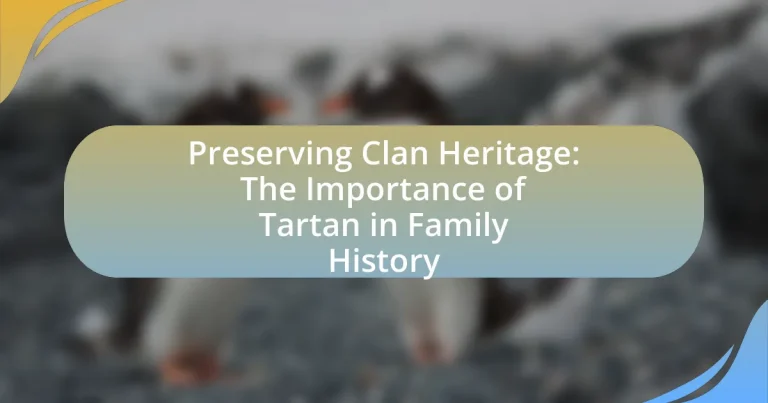Tartan is a crucial element of clan heritage, symbolizing identity and belonging for Scottish clans. Each tartan pattern is uniquely linked to specific clans, reflecting their history, values, and lineage, and has been used since the 16th century to foster unity and pride among members. The article explores the significance of tartan in representing family history, its origins, and the various types of tartan, including clan and district patterns. It also emphasizes the importance of preserving tartan for future generations, detailing how families can document their tartan heritage and maintain their cultural identity through traditional practices and contemporary uses.

What is the significance of tartan in clan heritage?
Tartan holds significant importance in clan heritage as it serves as a symbol of identity and belonging for Scottish clans. Each tartan pattern is uniquely associated with a specific clan, representing its history, values, and lineage. Historically, tartans were used to distinguish different clans and their members, fostering a sense of unity and pride among individuals. The use of tartan can be traced back to the 16th century, where it became a visual representation of clan affiliation, often worn during important ceremonies and gatherings. This connection to clan heritage is further reinforced by the fact that many tartans are registered with the Scottish Tartans Authority, ensuring their authenticity and preserving the cultural significance tied to each design.
How does tartan represent family history and identity?
Tartan represents family history and identity by serving as a visual symbol of clan affiliation and heritage. Each tartan pattern is associated with specific Scottish clans, reflecting their unique lineage and traditions. For example, the MacLeod tartan is distinct to the MacLeod clan, allowing members to express their identity and connection to their ancestry. Historically, tartans were used to signify social status and regional identity, reinforcing the importance of family ties within Scottish culture. The use of tartan in clothing and ceremonial occasions further solidifies its role as a marker of familial pride and continuity across generations.
What are the origins of tartan patterns in Scottish clans?
Tartan patterns in Scottish clans originated from the need for distinct identification among different groups and regions in Scotland. Historically, these patterns were created using local dyes and materials, resulting in unique designs that represented specific clans or families. The earliest documented use of tartan dates back to the 16th century, with references in literature and artifacts, such as the “Brocade of the Clan Campbell.” By the 18th century, tartan became more standardized, with the establishment of specific patterns associated with particular clans, solidifying its role in Scottish identity and heritage.
How do different tartan patterns signify different clans?
Different tartan patterns signify different clans by serving as unique identifiers that represent the heritage and lineage of Scottish families. Each clan has its own specific tartan design, characterized by distinct colors and patterns, which historically were used to denote clan affiliation and pride. For example, the MacLeod tartan features a bold yellow and black pattern, while the Campbell tartan is recognized for its green and blue stripes. These patterns not only reflect the clan’s identity but also their history, as many designs are linked to specific regions or events in Scottish history. The use of tartan has been documented since the 16th century, with the Scottish Tartan Society cataloging over 7,000 different tartans, each associated with particular clans, thus reinforcing the connection between tartan patterns and clan heritage.
Why is preserving tartan important for future generations?
Preserving tartan is important for future generations because it serves as a vital symbol of cultural identity and heritage. Tartan patterns are historically linked to Scottish clans, representing their unique histories, values, and traditions. By maintaining these patterns, future generations can connect with their ancestry and understand their familial roots, fostering a sense of belonging and continuity. The Scottish Register of Tartans, established in 2008, documents over 7,000 tartans, ensuring that this aspect of cultural heritage is safeguarded and accessible for educational and celebratory purposes.
What role does tartan play in cultural continuity?
Tartan plays a crucial role in cultural continuity by serving as a symbol of identity and heritage for Scottish clans. This distinctive fabric, characterized by its unique patterns and colors, is deeply intertwined with the history and traditions of specific clans, often representing their lineage and values. Historically, tartan patterns were used to signify clan affiliation, with each design being unique to a particular family or region, thus reinforcing a sense of belonging and continuity across generations. The revival of interest in tartan, especially during events like the Highland Games and clan gatherings, further solidifies its importance in maintaining cultural practices and fostering community ties among descendants.
How can tartan foster a sense of belonging among clan members?
Tartan fosters a sense of belonging among clan members by serving as a visual symbol of shared identity and heritage. The distinct patterns and colors of tartan are often associated with specific clans, creating a tangible connection to ancestry and tradition. This connection is reinforced during clan gatherings and events, where wearing tartan promotes unity and pride among members. Historical records indicate that tartan has been used for centuries to signify clan affiliation, with specific patterns recognized as representing particular families or regions, thus solidifying the bond among clan members through a shared cultural emblem.

What are the various types of tartan?
The various types of tartan include clan tartans, district tartans, fashion tartans, and military tartans. Clan tartans are specific to Scottish clans and represent their heritage, often used in kilts and other traditional attire. District tartans are associated with geographical areas rather than clans, reflecting local identity. Fashion tartans are designed for contemporary use and may not have historical significance, often created for commercial purposes. Military tartans are linked to specific regiments or military units, symbolizing their history and pride. Each type serves a unique role in representing cultural identity and heritage within Scottish tradition.
How are tartans classified?
Tartans are classified primarily by their patterns, colors, and the specific clans or regions they represent. Each tartan design consists of a unique arrangement of colored stripes, which can be categorized into various types such as clan tartans, district tartans, and fashion tartans. Clan tartans are associated with specific Scottish clans and often reflect the clan’s history and heritage, while district tartans represent geographical areas. Fashion tartans, on the other hand, are created for contemporary use and may not have historical ties. This classification system helps preserve the cultural significance of tartans in relation to Scottish identity and family lineage.
What distinguishes ancient, modern, and weathered tartans?
Ancient, modern, and weathered tartans are distinguished primarily by their color palettes and patterns. Ancient tartans typically feature softer, muted colors that reflect the natural dyes used historically, such as those derived from plants and minerals. Modern tartans, in contrast, utilize brighter, more vibrant colors achieved through synthetic dyes, resulting in sharper contrasts and clearer patterns. Weathered tartans exhibit a faded appearance, often resembling ancient tartans but with a more subdued color scheme, as if they have been exposed to the elements over time. This distinction is rooted in the historical context of tartan production and dyeing techniques, which have evolved significantly from the 18th century to the present day.
What are the differences between clan tartans and district tartans?
Clan tartans are specific patterns associated with individual Scottish clans, representing their unique heritage and identity, while district tartans are patterns that symbolize geographical regions rather than specific families. Clan tartans often have historical significance tied to the clan’s lineage, while district tartans are created to represent a broader community or area, allowing individuals from that region to wear a common pattern. For example, the MacDonald clan has its own distinct tartan, whereas the tartan for the Highlands represents the entire Highland region, illustrating the difference in focus between familial lineage and geographical identity.
What are the uses of tartan in contemporary society?
Tartan is used in contemporary society primarily for fashion, home decor, and cultural representation. In fashion, tartan patterns are prevalent in clothing items such as skirts, scarves, and jackets, often symbolizing Scottish heritage. In home decor, tartan is utilized in textiles like upholstery, curtains, and blankets, adding a traditional aesthetic to modern interiors. Additionally, tartan serves as a cultural emblem during events like Highland games and clan gatherings, reinforcing connections to Scottish ancestry and clan identity. The use of tartan in these contexts highlights its significance in preserving and celebrating clan heritage.
How is tartan incorporated into fashion and design today?
Tartan is incorporated into fashion and design today through its use in clothing, accessories, and home decor, reflecting both traditional and contemporary styles. Designers frequently utilize tartan patterns in collections, with brands like Burberry and Vivienne Westwood showcasing tartan in modern silhouettes, thereby maintaining its cultural significance while appealing to current fashion trends. Additionally, tartan is often featured in seasonal collections, demonstrating its versatility and enduring popularity, as evidenced by its presence in both high fashion runways and streetwear. This integration not only honors the heritage associated with tartan but also allows for creative reinterpretations that resonate with diverse audiences.
What role does tartan play in clan gatherings and ceremonies?
Tartan serves as a significant symbol of identity and heritage during clan gatherings and ceremonies. It represents the unique lineage and history of a clan, often worn by members to showcase their affiliation and pride. Historically, specific tartan patterns are associated with particular clans, reinforcing a sense of belonging and unity among members during events such as weddings, funerals, and festivals. The use of tartan in these contexts not only honors ancestral traditions but also fosters communal ties, as seen in events like the Highland Games, where tartan is prominently displayed, celebrating Scottish culture and clan identity.

How can families actively preserve their tartan heritage?
Families can actively preserve their tartan heritage by engaging in traditional practices such as weaving, wearing, and displaying tartan patterns in their homes. These activities not only keep the tartan culture alive but also foster a sense of identity and belonging among family members. For instance, participating in local clan gatherings or events that celebrate Scottish heritage can strengthen familial ties and educate younger generations about their ancestry. Additionally, documenting family history and stories related to tartan can create a tangible connection to the past, ensuring that the significance of tartan is passed down. Historical records indicate that clans have used tartan as a symbol of identity for centuries, making its preservation vital for maintaining cultural continuity.
What steps can families take to document their tartan history?
Families can document their tartan history by researching their ancestral lineage and identifying the specific tartans associated with their clan. This involves gathering historical records, such as birth and marriage certificates, and consulting clan societies or tartan registries that provide information on tartan patterns linked to particular families. Additionally, families can create a visual record by photographing tartan items, such as kilts or blankets, and compiling these images along with stories or anecdotes related to their tartan heritage. Engaging with local historians or participating in clan gatherings can further enrich their understanding and documentation of their tartan history.
How can families create a family tree that includes tartan heritage?
Families can create a family tree that includes tartan heritage by researching their ancestral lineage and identifying their clan affiliations. This process involves gathering historical records, such as birth, marriage, and death certificates, which often indicate clan connections. Additionally, families can consult tartan registries, such as the Scottish Register of Tartans, to find specific tartans associated with their clans. By documenting these connections in a family tree format, families can visually represent their heritage, showcasing both their lineage and the tartan patterns that symbolize their clan identity.
What resources are available for researching clan tartans?
Resources available for researching clan tartans include online databases, books, and historical societies. Websites like the Scottish Register of Tartans provide official records and details about various clan tartans, while books such as “Scottish Tartans: The Complete Guide” by James D. McClure offer comprehensive insights into the history and significance of tartans. Additionally, organizations like the Clan Tartan Society and local Scottish heritage centers can provide valuable information and resources for individuals interested in exploring their clan’s tartan heritage.
What are some best practices for maintaining tartan items?
To maintain tartan items effectively, it is essential to follow specific care practices. Regularly clean tartan fabrics by dry cleaning or hand washing in cold water with mild detergent to prevent color fading and fabric damage. Additionally, store tartan items in a cool, dry place away from direct sunlight to avoid deterioration and discoloration. Using acid-free tissue paper when folding tartan garments can help maintain their shape and prevent creasing. Furthermore, avoid using mothballs or chemical repellents that can harm the fabric; instead, consider natural alternatives like cedar wood. These practices are supported by textile conservation guidelines, which emphasize the importance of proper cleaning and storage to extend the lifespan of fabric items.
How should tartan garments be cared for to ensure longevity?
Tartan garments should be cared for by washing them in cold water and avoiding harsh detergents to ensure longevity. Cold water helps prevent shrinkage and color fading, while gentle detergents maintain the fabric’s integrity. Additionally, it is advisable to air dry tartan garments instead of using a dryer, as high heat can damage the fibers. Regularly brushing the fabric with a soft brush can also help remove dirt and maintain its appearance. These care practices are essential for preserving the quality and vibrancy of tartan, which is often made from wool or blended fibers known for their durability when properly maintained.
What are the best ways to display tartan heritage items in the home?
The best ways to display tartan heritage items in the home include using shadow boxes, wall hangings, and dedicated display shelves. Shadow boxes allow for the preservation of smaller items like brooches or fabric swatches while providing a visually appealing presentation. Wall hangings can showcase larger pieces, such as tartan blankets or banners, creating a focal point in a room. Dedicated display shelves can be used to arrange various tartan items, such as books, photographs, and memorabilia, allowing for easy access and appreciation. These methods not only highlight the significance of tartan heritage but also enhance the aesthetic of the home.





